
Area of zoo
Africa
Enclosure status
Open
IUCN status
Least Concern
Scientific name
Orycteropus afer
Order
Tubulidentata
Type
Mammals
Family
Orycteropodidae
Region
Africa
Habitat
Forest, savanna, and grassland
Aardvark facts
- Aardvarks are nocturnal and solitary animals, their name is Afrikaans and means "earth pig".
- Aardvarks create burrows which are important to other animals in their habitat. In South Africa, 27 other species were recorded using their burrows which help provide many animals protection from the heat and predators. These burrows are usually around 3 metres long, but sometimes reach up to 13 metres in length.
- Animals that use their abandoned burrows include African wild dogs, porcupines and hyenas. This makes them ecosystem engineers which support all wildlife living alongside them, especially during wildfires.
- Aardvarks are more closely related to elephants than anteaters, despite their appearance.
Aardvark diet
Aardvarks eat ants and termites, and can eat up to 50,000 insects in a single night. They sniff out with their sensitive noses and dig out with their powerful claws. Aardvarks have a long 30cm tongue which is extra thick, protecting them from insect bites.

Our aardvarks
Our aardvarks Terry and Dobby live alongside meerkats and porcupines, and their habitat features windows into their snug sleeping areas. You may be lucky enough to even see them sniffing around their habitat in the early evening, when the creatures scamper outside to ‘start their day’.
Aardvark threats
Aardvarks biggest challenges in the wild are the bush meat trade and habitat loss, which is being exacerbated by climate change.
Get animals in your inbox
Be the first to hear about all our newest animals, enclosures and arrivals by signing up to email updates from the Zoo.
